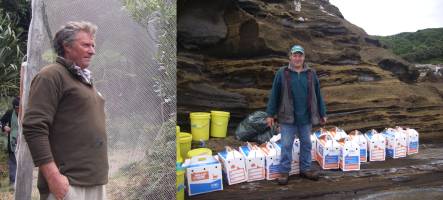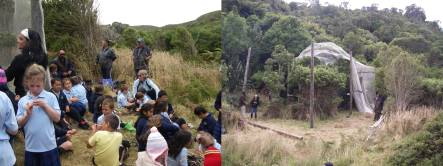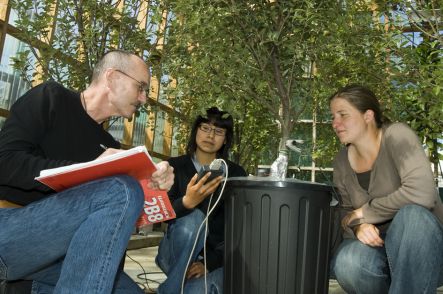Our Changing World for Thursday 29 April 2010
Chatham Island Tui Release Part 2

Bruce Tuanui next to the temporary aviary in the Awatotara Valley, and John Day with pet carry boxes holding tui on Rangatira Island (images: A. Ballance)
Last week we joined the Taiko Trust's Tui Team on Rangatira Island, as they attempted to catch 40 young tui to transfer to the main Chatham Island. In part two, we rejoin the team as they gather up the birds from the aviary on Rangatira, and release them into another holding aviary in the Awatotara Valley, a forest covenant on Liz and Bruce Tuanui's farm. On the day of the historic release nearly a sixth of the Chatham Island population - including the entire roll of the Te One School - turn up to help, and to cheer the birds on.

Te One School pupils waiting for the tui to be released, and the temporary aviary with the netting removed (images: A. Ballance)
Tuberculosis Research
 This year, World Day of Immunology was held on Thursday 29 April. It is a day aimed at raising awareness about the critical importance of the immune system in everyday life.
This year, World Day of Immunology was held on Thursday 29 April. It is a day aimed at raising awareness about the critical importance of the immune system in everyday life.
To mark World Day of Immunology, Ruth Beran meets Jo Kirman(pictured left) from the Malaghan Institute of Medical Research, who is looking at particular immune system cells to create a better vaccine for tuberculosis.
Tuberculosis is the most lethal known bacteria, claiming nearly two million lives every year, and newly infecting more than eight million people, and it's estimated that one New Zealander each day is being newly diagnosed with TB. Without an effective vaccine or other preventative measures, this figure is expected to rise.
New Zealand's Rare Plants

Shrubby tororaro planted in a median strip next to Wellington's Michael Fowler Centre (image: A. Ballance), and book cover featuring kakabeak
Threatened Plants of New Zealand is a new book which focuses on the 189 most threatened plants in the country. The book was produced by the Rare Plant Conservation Network, and it's five authors hope the book will serve as a call to arms, to inspire New Zealanders to protect their vanishing natural heritage, both in the wild and in their gardens. As well as glorious photographs of almost all the plants (in the case of several of the rarest plants no photos exist), the book contains some sobering facts. One in 13 of New Zealand's native plants is now threatened with extinction. Six plant species are already extinct, and even the popular garden plant the kakabeak is in serious trouble, with just one plant left in the wild. Another 24 species are known in the wild from fewer than 200 plants.
Threatened Plants of New Zealand by Peter de Lange, Peter Heenan, David Norton, Jeremy Rolfe and John Sawyer is published by Canterbury University Press (2010).
Virtual Water

From left to right: Plant & Food Research's Brent Clothier, Carmen Mellisho from the University of Murcia, and Anne-Cecile Larriqc from AgroParisTech (image: Plant & Food Research)
A water footprint is the total amount of water it takes to deliver a product or service, and in that sense is similar to carbon footprints which measure the total amount of greenhouse gas emitted to deliver a product or service. For example, did you know that it takes about 70 litres of virtual water to make one glass of beer?
Plant & Food Research'sBrent Clothier and Anne-Cecile Larricq from AgroParisTech are working out how to measure virtual water, and explain to Ruth Beran how a water footprint is actually determined.